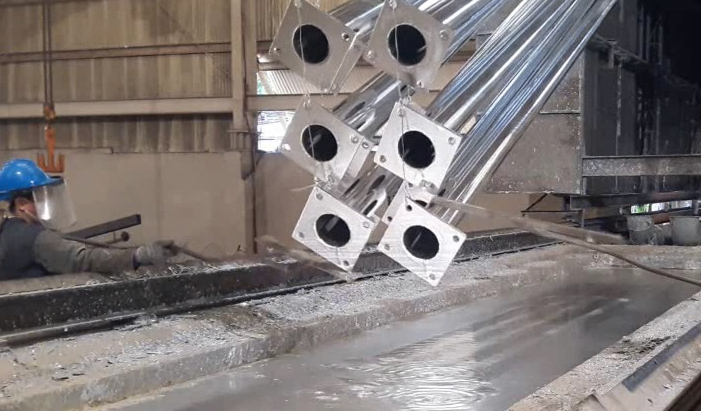
Hot-Dip Galvanizing is a protective coating on the surface of steel from oxidation or rusts with humidity in the air. This method contributes to the longer life of steel. It is suitable for works surrounding by humidity or the corrosion of the air such as the structure for outdoor installation.
Hot-Dip Galvanized processes are shown as following;
1. Preparation of steelwork
This step is a significant step. If you haven’t studied or planned the steel well, your work might not be plating by Hot-Dip Galvanizing. For instance, when the work is too large to be plated in the plating or if it can be plated, it will be more charged higher cost. Please prepare your work carefully if there are other factors that will cost you more such as the colour of the work. It will cost you additionally for a colour burning process.
2. Surface Cleaning
Surface Cleaning is required before galvanizing. It can be done in several ways depending on the workpiece.
- Rinsing – Washing workpiece with water to remove any debris or powder. It is used for ordinary workpieces without any special surface preparation.
- Blast – For plating or re-galvanizing, Sandblasting will make the surface of the workpiece perfect and a good surface will increase an ability of plating as well. Furthermore, sandblasting can solve the problem of skin problems, such as rust or colour work.
- Burn – For coloured work to be removed by burning with heat. There are no cleaning procedures that can remove the paint. (Extra charge is required)
- Pickling – In case the work is previously galvanized or Zinc plated. The work cannot be re-plated. Previous galvanizing or zinc plating must be removed from the workpiece surface before proceeding to the next plating procedure.
- Pickling with severe acid
When you finish the preparation of surface for plating, the work must be washed with acid again to remove small rusting on the surface of workpiece. It takes 3 hours procedure where the surface of the workpiece is problematic. It may be necessary to rinse with acid for 24 – 48 hours or longer depending on the condition of the workpiece (additional costs may be incurred if the workpiece has unusual skin conditions) or if the skin has to be repaired again.
4. Fluxing
When the work is washed with acid completely. Flux should be applied to the workpiece so that the specimens are well bonded.
5. Hot-Dip Galvanized Plating
After using bonding agents or binders, it is required to apply hot-dip galvanizing immediately. In this process, it is considered the most important step as well. The temperature is about 430-460 degrees Celsius by galvanizing. The process for plating is as follow;
- Shaking or swinging immediately which apply to screws or small jobs
- Normal plating without shaking for large workpieces
6. Finishing
To make the perfect surface, it may be polished with a sponge or wrinkle if it found some sag or have too thick zinc.
7. Inspection and Assurance
The thickness of zinc must be checked with a thickness checker and pre-delivery inspection to confirm that the customer meets the requirements perfectly.


